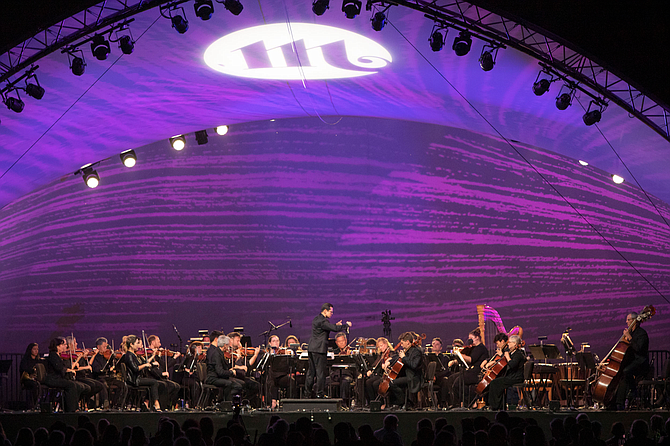 Facebook
Facebook
 X
X
 Instagram
Instagram
 TikTok
TikTok
 Youtube
Youtube

After attending just the first three concerts at the San Diego Mainly Mozart Festival, I concluded that it was, once again, a musical affair to remember. Mainly Mozart is onto something quite simple yet profound. Hire the best possible musicians you can find, and then let them do what they do. The result is a consistent level of musical excellence that is unrivaled anywhere.
On Saturday, September 11, there were two pieces of music on the program which were, in my estimation, astounding. The first was Mozartiana by Tchaikovsky. Mozart was Tchaikovsky’s favorite composer, and he paid his respects with this charming pastiche of Mozart melodies a la Tchaikovsky. Both Mozart and Tchaikovsky are amongst my favorite composers, and that made the piece a sheer delight. The other astounding piece of music on Saturday was Pedro Iturralde Ochoa’s Pequeña Czardas. This is a showpiece for saxophone. Playing the solo was saxophone legend Branford Marsalis. This was a new piece of music to me and I loved it. As an encore, Marsalis engaged in an impromptu jam session with violinist Zach DePue and bassist Scot Pringle. Both DePue and Pringle stepped forward from the orchestra and showed that their musical range extended far beyond the confines of the conservatory.
Sunday, September 12, was all about violinist Benjamin Beilman as he ripped through both Havanaise by Camille Saint-Saëns and Tzigane by Maurice Ravel. These are considered standard for the violin repertoire, but that doesn’t make them insignificant musical mountains to traverse.
And on Tuesday, September 14, the soloists stood out again. The first piece was the Sinfonia Concertante by Joseph Haydn. The most famous Sinfonia Concertante is Mozart’s version for violin, viola, and orchestra. Haydn’s is for violin, cello, oboe, bassoon, and orchestra. The soloists were pulled from the orchestra and together, they created a world-class quartet. Martin Chalifour, concertmaster of the LA Philharmonic, was the violinist. Mark Kosower, principal cello of The Cleveland Orchestra, was the cellist. Eugene Izotov, principal oboe of The San Francisco Symphony, handled the oboe solo, and Whitney Crockett, principal bassoon of the LA Philharmonic, was on the bassoon solo. This quartet provided a fine example of Mainly Mozart’s approach of hiring the best musicians to be found and turning them loose.
Violinist Grace Park concluded the evening with Mozart’s exquisite Violin Concerto No. 3 and the Introduction and Rondo Capriccioso by Saint-Saëns. Park displayed a perfect Mozartian temperament with the Violin Concerto No. 3 and then ignited a romantic display of musicianship with the Saint-Saëns.


After attending just the first three concerts at the San Diego Mainly Mozart Festival, I concluded that it was, once again, a musical affair to remember. Mainly Mozart is onto something quite simple yet profound. Hire the best possible musicians you can find, and then let them do what they do. The result is a consistent level of musical excellence that is unrivaled anywhere.
On Saturday, September 11, there were two pieces of music on the program which were, in my estimation, astounding. The first was Mozartiana by Tchaikovsky. Mozart was Tchaikovsky’s favorite composer, and he paid his respects with this charming pastiche of Mozart melodies a la Tchaikovsky. Both Mozart and Tchaikovsky are amongst my favorite composers, and that made the piece a sheer delight. The other astounding piece of music on Saturday was Pedro Iturralde Ochoa’s Pequeña Czardas. This is a showpiece for saxophone. Playing the solo was saxophone legend Branford Marsalis. This was a new piece of music to me and I loved it. As an encore, Marsalis engaged in an impromptu jam session with violinist Zach DePue and bassist Scot Pringle. Both DePue and Pringle stepped forward from the orchestra and showed that their musical range extended far beyond the confines of the conservatory.
Sunday, September 12, was all about violinist Benjamin Beilman as he ripped through both Havanaise by Camille Saint-Saëns and Tzigane by Maurice Ravel. These are considered standard for the violin repertoire, but that doesn’t make them insignificant musical mountains to traverse.
And on Tuesday, September 14, the soloists stood out again. The first piece was the Sinfonia Concertante by Joseph Haydn. The most famous Sinfonia Concertante is Mozart’s version for violin, viola, and orchestra. Haydn’s is for violin, cello, oboe, bassoon, and orchestra. The soloists were pulled from the orchestra and together, they created a world-class quartet. Martin Chalifour, concertmaster of the LA Philharmonic, was the violinist. Mark Kosower, principal cello of The Cleveland Orchestra, was the cellist. Eugene Izotov, principal oboe of The San Francisco Symphony, handled the oboe solo, and Whitney Crockett, principal bassoon of the LA Philharmonic, was on the bassoon solo. This quartet provided a fine example of Mainly Mozart’s approach of hiring the best musicians to be found and turning them loose.
Violinist Grace Park concluded the evening with Mozart’s exquisite Violin Concerto No. 3 and the Introduction and Rondo Capriccioso by Saint-Saëns. Park displayed a perfect Mozartian temperament with the Violin Concerto No. 3 and then ignited a romantic display of musicianship with the Saint-Saëns.
Comments